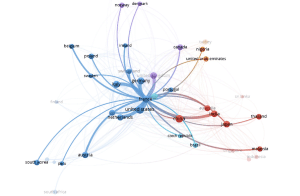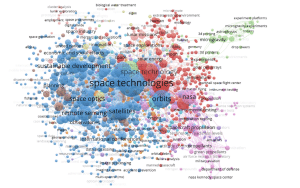DEFINING THE CONCEPT OF GREEN SPACE TECHNOLOGY
N. PULSIRI, V. DOS SANTOS PAULINO
Corresponding Author: TBS Business School, 1 Place Alphonse Jourdain, 31068, Toulouse, France, n.pulsiri@tbs-education.fr; v.dossantospaulino@tbs-education.fr
Abstract
The world is currently facing increasing sustainability challenges both on Earth and in space. To ensure the continued benefit of space activities for humanity, it is crucial to find solutions that address these challenges. This paper aims to explore and analyze the concept of Green Space Technology (GST), which focuses on developing and managing space technologies with minimal environmental impact. A bibliometric analysis was conducted on 1,464 publications related to GST. The findings reveal that several countries are collaborating globally on this research. Additionally, two main research themes emerged, which are GST for preserving Earth and space’s environments. Based on these insights, this paper proposes the definition of GST as a space technology designed to perform space activities that causes minimal environmental impact or contributes to environmental preservation both on Earth and in space.
Key words: Green space technology, sustainability, innovation, environment, earth, space.
Introduction
Presently, humanity lives in an interconnected world where advancements in technology and innovation have transformed lifestyles and revolutionized how various businesses operate to deliver value to the society (1-3). The space sector is also promising to drive the next phase of the global economy, encouraging spin-offs of various innovations, and creating new value for other related sectors (4, 5). Therefore, the space sector is no longer limited to traditional space-faring countries. Instead, an increasing number of emerging space countries and companies will actively participate in sundry activities within the global space ecosystem.
However, the new trend of “new space”, which is transforming the business landscape into the commercialization of space, has also given rise to some challenges such as space debris and environmental impact of space activities on Earth’s environment (3, 5, 6). For example, the rapid growth of space launches, without careful consideration of their environmental impact, has significantly caused the escalation of space debris and the degradation of the space’s environment (7, 8). In the worst case, the increasing volume of space debris could collide with and damage all active space objects that provide crucial services (9).
To address these critical issues, solutions must be profound on the development of advanced space technologies that prioritize environmental preservation (8, 10). This could include designing more sustainable spacecraft, improving life cycle for space missions, and creating technologies that minimize the generation of space debris (11). Technologies that achieve these goals while minimizing environmental impact can be categorized as “Green Space Technology”.
However, the concept of Green Space Technology (GST) remains undefined. Therefore, it is essential to establish a clear definition of GST, supported by findings from bibliometric analysis. This paper aims to introduce an initial concept of GST with insights from bibliometric research.
Green Space Technology (GST)
The international community acknowledges the growing concerns around sustainable space, especially regarding the growing presence of space debris in Earth’s orbit and environmental impacts from various space activities (12, 13). Thus, advancing scientific research in space sustainability is vital to safeguarding space assets and preserving the environment for future generations. One promising approach to addressing these challenges is the development and adoption of space technologies designed to have minimal or no impact on both Earth and space’s ecosystems, taking their entire life cycle into account (11).
To better understand this approach, it is helpful to consider the broader concept of “technology”. Dosi (14) defines technology as “… a set of pieces of knowledge, both directly “practical” (related to concrete problems and devices), and “theoretical” (but practically applicable although not necessarily already applied), know-how, methods, procedures, experience of successes and failures, and also of course, physical devices and equipment” (p. 151-152). This definition underlines the multifaceted nature of technological development, encompassing both tangible and intangible components.
Building on this foundation, the concept of Green Space Technology (GST) can be further clarified by addressing its dual focus on the “Earth” and “Space” environments. GST can be defined as “A space technology designed to perform space activities that causes minimal environmental impact or contributes to environmental preservation both on Earth and in space” (Own analysis). By incorporating this dual focus, GST represents a holistic approach to ensuring sustainability in the rapidly evolving domain of space application, exploration and utilization.
Bibliometric analysis method
The focus of the bibliometric analysis is on Green Space Technology (GST), which represents the intersection of the concepts of “green” and “space technology” is based on the previous research of Dos Santos Paulino and Pulsiri (3), and Pulsiri and Dos Santos Paulino (11). This analysis seeks to explore the extent of research conducted in this emerging field. To achieve this, the SCOPUS database was selected for retrieving publications. A systematic search strategy was employed by using (green OR ecolog* OR environment* OR sustain* OR debris) AND (“space technology” OR “space technologies”). 1,464 publications were selected from this process. For the bibliometric analysis, VOSviewer, a widely used tool for constructing and visualizing bibliometric networks, was utilized for the visualization of the mapping and clustering of data to reveal knowledge patterns and insights.
Results
The country collaboration network, based on co-authorship analysis, shows that France is positioned at the center of Figure 1, highlighting its significant role in Green Space Technology (GST) research. France is surrounded by numerous collaborating countries from across the globe, including both space-faring nations and others. These countries include Germany, Italy, Portugal, Sweden, Poland, Belgium, the Netherlands, Norway, Denmark, Ireland, the UK, the US, Austria, Peru, South Korea, Canada, Nigeria, the United Arab Emirates, China, the Czech Republic, Brazil, Australia, India, Thailand, Japan, and Malaysia.
Regional collaboration patterns are evident in the network. European countries tend to collaborate more closely with each other, forming a strong intra-regional network, while countries in Asia display similar regional clustering. Despite these regional tendencies, some countries, such as France, play a pivotal role in connecting various countries worldwide, demonstrating their active engagement in GST research and collaboration. This widespread global involvement reflects the increasing attention GST research is receiving and highlights its importance in addressing pressing environmental and technological challenges in space activities
The research themes by co-occurrence analysis revealed that the development of Green Space Technology (GST) is closely linked to keywords related to both Earth and space’s environments. For instance, keywords related to Earth’s environment, such as remote sensing, observatories, and sustainable development, highlight the role of GST in promoting sustainability on Earth. These technologies focus on addressing environmental challenges and supporting eco-friendly practices on the planet.
On the other hand, there are keywords concerning space missions that extend beyond Earth’s atmosphere, particularly life cycle assessment, eco-design, in-orbit servicing, and debris removal. These terms emphasize the importance of GST in mitigating the environmental impact of space activities and ensuring the sustainability of space operations.
In summary, GST plays a direct role in the preservation of both Earth and space environments. Unlike other technologies that can harm the environment, GST is designed to be green and environmentally friendly, contributing to the long-term sustainability of both terrestrial and extraterrestrial ecosystems.


Discussion and conclusion
The global community has acknowledged the sustainability challenges facing the space sector, particularly the growing concerns over space debris and the ecological impact of space missions. Many researchers are currently working to address these issues, with the development of environmentally friendly space technologies, referred to as “Green Space Technology (GST)” which emerges as a promising solution (ESA, 2023; Dos Santos Paulino et al., 2024). Given that the space sector is primarily driven by technological innovation and offers significant economic and societal benefits, a technology-push approach is well-suited to tackle these challenges and encourage collaboration among various stakeholders.
The analysis from this research highlights that several countries, such as France, are actively focusing on GST and collaborating with a wide range of countries worldwide in this area. Additionally, the research themes identified in the analysis contribute to the development of GST solutions aimed at preserving both Earth and space’s environments.
References
- Halal, W.E. (2013). Forecasting the technology revolution: Results and learnings from the TechCast project, Technological Forecasting and Social Change, 80(8), 1635-1643.
- Dos Santos Paulino, V. (2020). Trajectoies d’Innovation dans l’Industrie Spatiale, ISTE Editions Ltd.
- Dos Santos Paulino, V. and Pulsiri, N. (2022). Safeguarding Earth and space’s environment: Issues and trends towards sustainable development, International Journal of Technology Management and Sustainable Development, 21(3), 357-376.
- Cloitre, A., Dos Santos Paulino, V. and Theodoraki, C. (2022). The quadruple/quintuple helix model in entrepreneurial ecosystems: an institutional perspective on the space case study, R&D Management, 53(4), 675-694.
- Dos Santos Paulino, V., Pulsiri, N. and Bénaroya, C. (2024). Navigating disruptions with bibliometrics: The new space case, Journal of Innovation Economics and Management, 44, 137-160.
- Maury, T. (2019). Consideration of space debris in the life cycle assessment framework, PhD Thesis: Université de Bordeaux.
- OECD (2020). Space Sustainability, Éditions OCDE, Paris.
- OECD (2021). Space Economy for People, Planet and Prosperity, Éditions OCDE, Paris.
- Kessler, D.J., and Cour-Palais, B.G. (1978). Collision frequency of artificial satellites: The creation of a debris belt, Space Physics, 83(A6), 2637-2646
- ESA (2023). Green Dossier, https://business.esa.int/sites/business/files
- Pulsiri, N. and Dos Santos Paulino, V. (2024). The green path to space sustainability: Twenty years of research, International Journal of Technology Management and Sustainable Development, 22(3), 299-318.
- ESA (2022). Green Technologies, retrieved from https://www.esa.int
- EUSPA (2023). EU Space for Green Transformation, European Union
- Dosi, G. (1982). Technological paradigm and technological trajectories: A suggested interpretation of the determinants and directions of technological change, Research Policy, 22, 102-103.
